Summary of August Macke
Despite his life being cut tragically short during World War One, August Macke had a profound impact on multiple major artistic movements of the 20th century. After early experiments with Impressionist and Fauvist techniques, Macke went on to work closely with German painter and printmaker, Franz Marc to develop a more abstract, colorful and emotive style. Macke was one of the leading members of the Expressionist group, Der Blaue Reiter and exhibited with Wassily Kandinsky and Marc in the group's first, historic exhibition in 1911. Becoming disillusioned with Kandinsky's work, however, Macke soon set out on a quest to develop a unique visual language that incorporated elements from styles as diverse as Cubism, Orphism, and Futurism. Through a deeply personal exploration of the spiritual, mystical and emotional realms of the human condition, the result was a body of work unprecedented in the history of art.
Accomplishments
- Macke's uniquely expressive style - created by incorporating elements and techniques from Impressionism (specifically, exploring the color effects of light and a stippling brush technique), Fauvism (use of vivid, saturated color and broad brushstrokes) and German Expressionism (abstract backgrounds, flat colored shapes, heavy black lines and thick brushstrokes) - resists classification in any one style or group. Macke's work is therefore a key example of an artist successful in the complex task of creating an original, contemporary style to meet expressive ends by synthesizing specific elements from parallel artistic movements.
- Expressive color and energetic line were a means by which Macke sought to make sense of the human condition in the face of the rapid social and technological changes convulsing Europe in the early-20th century, and which ultimately led to the First World War. Macke's work was therefore particularly influential on Surrealist artists who sought political freedom and freedom of expression following the horrors of the First World War (in which Macke himself was killed).
- Macke was first and foremost a colorist, equally adept in both oil paint and watercolor. While he did not produce a developed theory of color (unlike his fellow Der Blaue Reiter painter, Wassily Kandinsky), he nevertheless used color to express and communicate universal aspects of human consciousness - love, hate, fear, joy, etc. The artist's job, he wrote, is to explore and express the human soul - our inner life - via representation of form and use of (non-naturalistic) color. Macke lived by and practiced this philosophy throughout his short but immensely impactful life.
The Life of August Macke
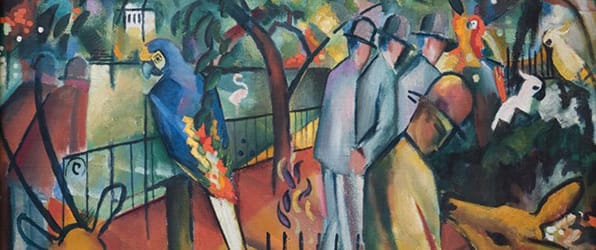
August Macke was fortunate to be sponsored by his wife's rich uncle to travel around Europe and explore a range of artistic styles... one can only imagine where his career could have led were he not tragically killed in battle in the early stages of WWI.
Important Art by August Macke
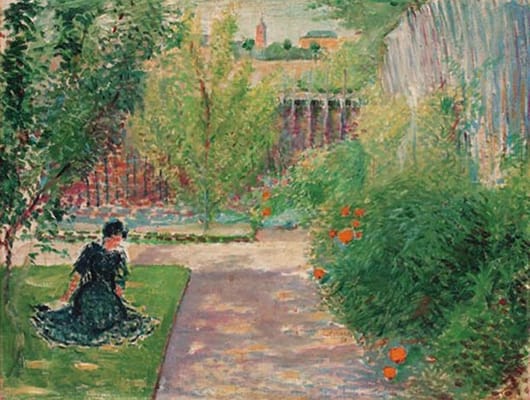
Sonniger Garten (Sunny Garden)
In this painting, a girl in a dark dress - believed to be Elisabeth Gerhardt, the woman Macke would marry in 1909 - kneels on the grass in a garden with pathways, flowering bushes, and trees. The dappled sunlight falls around her, contrasting with the brighter area behind her. At the right edge of the image is a tall white wall enclosing the garden, upon which Macke explored the color effects that the sunlight would have upon such a surface.
After spending just two years in an academic arts training setting, Macke quit his studies at the Düsseldorf Academy, yearning to explore the more avant-garde artistic movements developing around Europe. He began traveling around the continent in 1905 to see modern developments in art for himself. The most inspiring of these early experiences were his first two trips to Paris, in 1907 and 1908, where he encountered the work of the Impressionists. In works like Sunny Garden, which was painted in his hometown of Bonn, Germany, he soon began emulating their style. Here, Macke tried his hand at the stippling technique he had no doubt viewed in the works like Alfred Sisley and Claude Monet, creating the mottled light effect of the bright sun filtering through the leaves of the trees. Overall, the work competently embraces the warm, intimate, and serene atmosphere common to French Impressionist works of the period.
Oil on canvas - Private collection
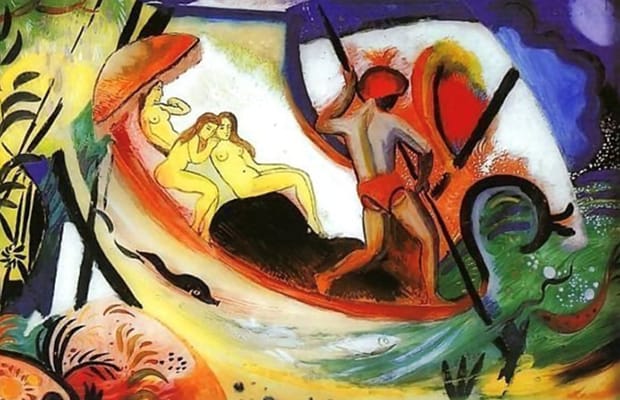
Drei Madchen in einer Barke (Three Girls in a Barque)
On his third trip to Paris, in 1909, Macke discovered a bold new group of French artists, the Fauves, which included Henri Matisse and André Derain. He was fascinated by their use of vivid, saturated, less-naturalistic colors, flat figures, broad brushstrokes, and their evident movement toward further abstraction (compared to the Impressionists). In Three Girls in a Barque, he employed all these techniques in his depiction of three nude female figures lounging on a boat with a semi-nude male oarsman appearing to steer the boat gracefully through tumultuous waters. At the same time, however, Macke incorporated elements of another burgeoning modern, German art movement, Expressionism, which was being practiced by his close friend Franz Marc and his colleague Wassily Kandinsky. The expressionist elements of this painting can be found in the abstract background and borders, comprised of flat colored shapes and thick sweeping black lines, as if creating an entirely expressionist, dream-like landscape for his fauve (wild) figures to navigate through.
Macke asserted that "the intersection of two styles will create a third, new style." Here, and throughout his brief yet productive career, he evidently sought to do just that, taking avant-garde movements and styles that were still in their infancy, and blending them together, ultimately creating unique artistic languages that influenced his fellow avant-garde artists and that were still further removed from the staid academic artistic traditions he had so strongly resented as a student.
Oil on canvas
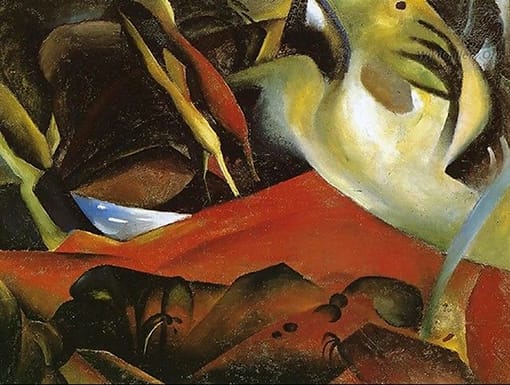
Der Sturm (The Storm)
In 1911, Macke joined the newly-formed Der Blaue Reiter group of artists, which also included his friends Franz Marc and Wassily Kandinsky. Like the Die Brücke group, the Der Blaue Reiter artists were a key group within German Expressionism. However, the latter was more concerned with evoking the spiritual, mystical, and emotional realms through art, and thus more fully embraced abstraction in their work. As arts writer Paul D. Wilke explains, "details were less important here than the emotional response provoked by the painting." Macke produced The Storm while involved with the Der Blaue Reiter group. The painting is typical of the group's style in its use of evocative, contrasting colors. The abstracted landscape and extreme weather bear the influence of Marc, and the curious forms found within the paintings, as well as in the 'storm' above, are suggestive of human or animal features, such as horses (which also featured prominently in Marc's paintings).
One year after he created this painting, Macke's essay "Masks" was published in the Der Blaue Reiter Almanac. In it, he put into words the group's philosophy of finding the spiritual in art, lending further context to his paintings from this period, and perhaps to The Storm in particular. He wrote: "To create forms means: to live. [...] Forms are powerful expressions of powerful life. Differences in expression come from the material, word, color, sound, stone, wood, metal. One need not understand each form. [...] The thunder expresses itself, as does the flower; each force manifests itself as a form. And so does the human being."
We could thus potentially understand The Storm not so much as a representation of an actual meteorological event, but rather a metaphorical storm of the artist's own creative impulse. At the same time, in this, and other works produced by Macke while involved with the Der Blaue Reiter group, art historian Johannes Langner also notes that the artist included the "schematic plastic form" typical of Cubism, as well as a sense of energy characteristic of Fauvism. Indeed, although throughout his career he continued to explore new artistic styles, he never fully abandoned one as he moved on to another.
Oil on canvas - Saarlandmuseum - Moderne Galeire, Saarbrücken, Germany
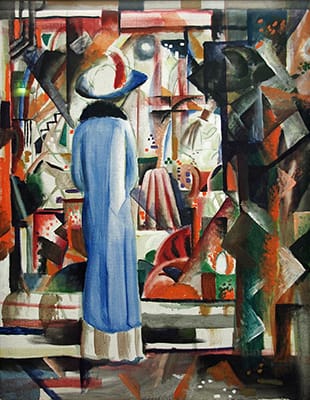
Großes helles Schaufenster (Large Bright Shop Window)
In 1912, Macke met Robert Delaunay in Paris, and was deeply influenced by the Orphism style that Delaunay had pioneered. Orphism was one of the earliest movements to embrace complete abstraction, and also incorporated philosophies of color harmonies and the visual representation of music. As arts writer Paul D. Wilke explains, "Delaunay seemed to capture in exquisite form what the Blue Riders were after; that is, color as a kind of non-verbal language communicating emotions through the medium of art." Although he embraced this new style, Macke rarely produced entirely abstract works, instead retaining figuration in his Orphism-inspired paintings. He also often maintained the quotidian scenes of urban leisure, and domestic scenes, favored by the Impressionists, producing what curator and art historian Heather Hess describes as, "luminous scenes of elegant urban flaneurs window-shopping and strolling through parks."
One such work is Large Bright Shop Window, which shows a simply-rendered woman in a long blue coat with a black fur collar, and a hat with a red feather, facing away from the viewer looking into a shop window. It is in the window display, as well as on the street below the woman, that we find elements of Orphic Cubism (similar to works by Delaunay, like Simultaneous Windows (1912)) - a frenzied, fractured amalgamation of sharply-defined rectangular shapes, rendered mostly in black, red, and white, with small sections of blue and green. The frenetic, incoherent scene into which the woman looks could be understood, first, as an exploration on the part of the artist into the way in which reflections of the city behind the woman would be overlaid on the glass with the shop display behind the window. Indeed, Macke was forever intrigued by the visual qualities of light, and even worked occasionally in glass-painting. Secondly, however, considering Macke's long-held interest in realms that lay beyond the mere physical, this painting may also be understood as a visual representation of the unsettled, frantic emotional/psychological state often associated with the modern city dweller.
Oil on canvas - Sprengel Museum, Hanover, Germany
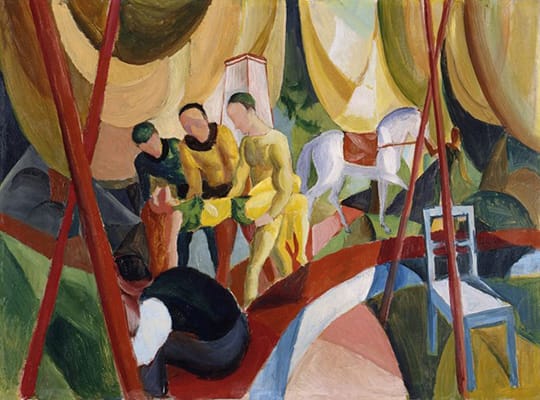
Circus
After moving away somewhat from the Der Blaue Reiter group, Macke developed an interest in Futurism, as well as Orphism. He combined these influences in Circus, which depicts three male acrobats tenderly carrying the body a female circus performer who has fallen off a white horse (which is being led out of the circus tent by another figure to the right of the image). Another figure, dressed in a white shirt and black vest and pants is seated, facing away from the viewer, with his upper body drawn down close to his legs, as if in disbelief and/or grief. In Circus, Macke rendered the interior of the circus tent in a fragmented and semi-abstracted manner, similar to the works of the Orphists and the Futurists, with large blocks of bold colors and sweeping forms suggesting movement. Art conservator Paloma Alarcó notes that, "the luminous colouring, a common feature of his entire oeuvre, creates a brilliant and unreal atmosphere that heightens the unsettling pathos of the scene."
Macke became interested in the circus theme while in Hilterfingen, Switzerland, where he and his wife Elisabeth saw a family of circus performers called Knie performing tightrope acts in the market square. Elisabeth later recounted how this "unusual spectacle in richly contrasting colours such as one rarely sees [...] made a deep artistic impression on August, who translated these experiences in masterly fashion into numerous drawings and paintings." Alarcó also writes that, "In this work the circus reveals its dual nature, in which merriment can instantly transform itself into profound sadness and in which danger and death constantly lie in wait," adding that "the fragile rider and the circus" could be seen as metaphors for the way Macke felt himself, as an artist "located on the margins of society in a way comparable to circus people."
With Europe on the verge of World War I, it is likely that the artist may also have been using the idea of the duality of the circus as a metaphor for the simmering chaos in European society more broadly. Indeed, though he had begun to move away from what Alarcó describes as "the mystic and symbolic concerns of Der Blaue Reiter," returning to "concentrating on the visible world," Macke nevertheless continued to imbue his works with symbolism and analogy. Art historian Ursula Heiderich even views Macke's Circus as a sort of modern pietà.
Oil on cardboard - Museo Nacional Thyssen-Bornemisza, Madrid
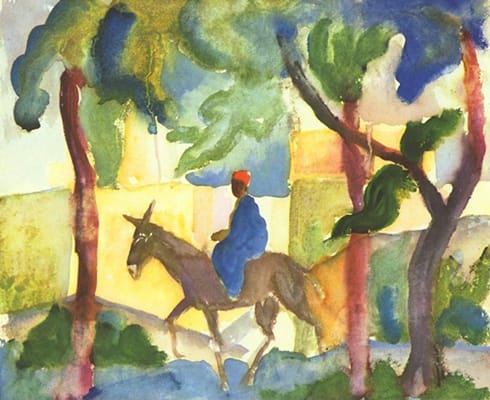
Donkey Rider
In April 1914, just months before his death, Macke travelled to Tunisia with fellow artists Paul Klee and Louis Moilliet. While there, he was deeply inspired by the atmospheric and light effects he witnessed in the exotic North African landscape. Nearly all the works he produced between this trip and his passing represent his attempts to capture these qualities in paint. Many of the works made during this final period were completed in watercolor (rather than the oil paint he had tended to prefer previously), likely intended as preparatory sketches to be made into paintings later. Macke never got the chance to achieve this.
Donkey Rider is one of his watercolors from this period. It shows a figure in a red hat or turban and a blue robe, riding a donkey across a verdant landscape with three trees in the foreground. The abstract background, which represents the fortress wall of Tunis, is comprised of large rectangular blocks of bright blue, green, and yellow paint, which almost mimic a stained-glass window. It is likely that this painting represents a specific experience Macke had in Tunisia, as it is known that he took a donkey ride with a guide during a visit there.
Watercolor - August-Macke-Haus, Bonn, Germany
Biography of August Macke
Childhood
August Robert Ludwig Macke was born in Meschede, Westphalia, Germany. He was one of three children (and the only son) born to father August Friedrich Hermann Macke, who worked as a civil engineer and building contractor, and mother Maria Florentine (born Adolph) who was from a family of farmers. When August was a baby, the family moved to the city of Cologne. He attended the Kreuzgymnasium (one of the oldest elementary schools in Germany) where he befriended future fellow painter, Hans Thuar.
When August was a child, his father enjoyed drawing and painting in his spare time, particularly landscapes, which inspired his son. Young August also enjoyed looking at the ancient artifacts collected by his father and the Japanese prints collected by Thuar's father. He also became enamored with the paintings of Arnold Böcklin, which he saw on a trip to Switzerland in 1900. When August was thirteen, his family moved again, this time to Bonn, where, while a secondary school student at the Realgymnasium, he met his future wife, Elisabeth, the sister of Macke's friend, Walter Gerhardt.
Education and Early Training
In 1904, Macke's father passed away. That same year, he left high school a year early and began studying at the Kunstakademie Düsseldorf, under German landscape and genre painter Adolf Maennchen. However, he quickly grew tired of the traditional, academic approach to art making and particularly disliked having to faithfully copy the Old Masters instead of exploring new artistic ideas. He left the academy after just two years and instead enrolled in night classes with graphic designer, illustrator, and typographer Fritz Helmut Ehmke. He also took on side work as a stage and costume designer at the Schauspielhaus Düsseldorf.
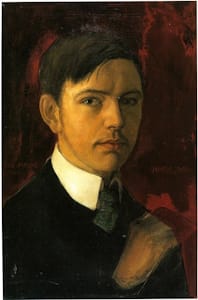
In 1905, Macke began taking trips to northern Italy, the Netherlands, Belgium, and Great Britain. His travels around Europe were funded by wealthy art collector Bernard Koehler, who was the uncle of Elisabeth Gerhardt, the girl he had befriended in secondary school. Macke's early trips to Paris, between 1907 and 1909, where he discovered the work of the Impressionists and the Fauvists, were especially inspiring. Later in 1907, he spent time in Berlin studying under German artist Lovis Corinth, who blended elements of Impressionism and Expressionism in his painting and printmaking. Then, while in Munich in 1909, Macke met Expressionist painter Franz Marc, and the two began working together closely, exploring and developing a more abstracted, colorful, and emotive style.
Mature Period
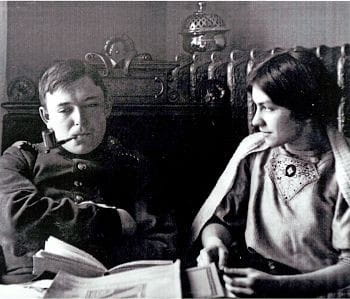
Macke married Elisabeth Gerhardt in 1909. She became his main muse, sitting for him for over 200 portraits over the next five years. In 1911, Macke joined the Der Blaue Reiter group, which had been founded earlier that year by Marc and Wassily Kandinsky, both of whom had been involved with, and wanted to break away from, the Neue Künstlervereinigung München (Munich New Artists' Association) and the Die Brücke group. In comparison with the Die Brücke group, who embraced a certain amount of "ugliness" in their art, and who retained a certain degree of figuration, the Der Blaue Reiter artists were focused on creating harmony through form and color, and embraced total abstraction. Macke's works were included in the First Exhibition by the Editors of Der Blaue Reiter, which was held in Munich from December 1911 to January 1912 before going on to tour Europe until July 1914.
In May of 1912, Macke's essay "Die Masken" ("The Masks") was published in the Der Blaue Reiter Almanac. In it, he put forth his philosophy on the quest for the spiritual through art, writing that "Intangible ideas express themselves in tangible forms. Tangible through our senses as a star, thunder, flower, as form. Form is a secret to us, because it is the expression of secret forces. Only through it do we sense the secret forces, the 'invisible God'. The senses are our bridge from the intangible to the tangible."
In 1912, while in Paris, Macke met Robert Delaunay, and was fascinated by his newly developed Orphism style. By 1913, when he moved to Hilterfingen, Switzerland, Macke favored Delauney over Kandinsky, writing about his disillusionment with the latter in a letter to Marc: "My painter's opinion is that Kandinsky has gently passed us by, because Delaunay's work was hung next to his, and therefore showed how vivid color can be, in comparison to an incredibly complicated, but dull, composition of colored dots. It is enough to make one want to cry from disillusion and shattered hopes." Around this time, he also drew inspiration from Italian Futurism. In April of 1914, he travelled to Tunisia with fellow Der Blaue Reiter artists Paul Klee and Louis Moilliet, where the atmospheric effects he witnessed in the exotic landscape led him to explore how to infuse a painting with the effect of light emanating from within.
Death
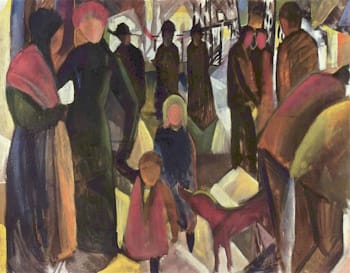
In the first week of World War One, Macke volunteered to fight for his country. Within just a few weeks of going to war, he wrote in a letter to his wife, "I would consider myself incredibly lucky if I was to return from this war. I think about all the beautiful things that I have witnessed and that I have you to thank for." Tragically, less than two months into the war, on September 26, 1914, he was killed in battle at the front in Champagne, France. Macke is buried in the German Military Cemetery in Souain-Perthes-lès-Hurlus. Curator and art historian Heather Hess explains how later, "As a fallen veteran, German officers protested the confiscation of his works and his inclusion as a degenerate artist by the Nazis."
Macke's friend and fellow artist, Franz Marc (who would also die on the battlefield just two years later) stated in his eulogy to Macke, "We painters know that without his harmonies, whole octaves of colour will disappear from German art, and the sounds of the colours remaining will become duller and sharper. He gave a brighter and purer sound to colour than any of us; he gave it the clarity and brightness of his whole being. With his death one of the most promising and daring lines of development of our German art has been abruptly severed; none of us are capable of carrying it forward." In 1991, the August-Macke-Haus was founded in Bonn as a museum dedicated to his work.
The Legacy of August Macke
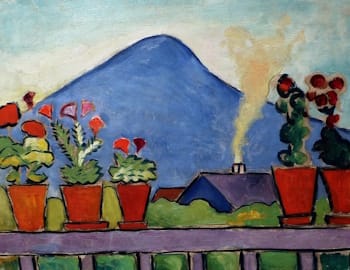
The sudden death of August Macke at the age of just twenty-seven, while on the front lines of WWI, stands amongst the most tragic losses in the history of art. In under a decade of his artistic career, he demonstrated not only profound technical talent, but also fascination with a vast range of avant-garde styles. He had a deep desire to be on the front lines of developing an artistic language that would be unprecedented not just visually, but philosophically and spiritually. Though most often cited in relation to his involvement with the Der Blaue Reiter group of Expressionists, Macke was just as notable as an Impressionist, a Cubist, and an Orphist. As Andreas Henning, director of the Museum Wiesbaden notes, though the story of Macke's premature demise as a young soldier is a wholly heartbreaking one, the oeuvre he left behind, comprised of over 10,000 paintings, drawings, and sketches, "exude[s] joy, easefulness, and lightness of being: [his works] really seem to want to reconcile us with life."
Influences and Connections

-
![Arnold Bocklin]() Arnold Bocklin
Arnold Bocklin -
![Henri Matisse]() Henri Matisse
Henri Matisse -
![André Derain]() André Derain
André Derain - Adolf Maennchen
- Fritz Helmut Ehmke
-
![Franz Marc]() Franz Marc
Franz Marc -
![Wassily Kandinsky]() Wassily Kandinsky
Wassily Kandinsky -
![Robert Delaunay]() Robert Delaunay
Robert Delaunay -
![Paul Klee]() Paul Klee
Paul Klee - Otto Soltau
-
![Franz Marc]() Franz Marc
Franz Marc -
![Wassily Kandinsky]() Wassily Kandinsky
Wassily Kandinsky -
![Robert Delaunay]() Robert Delaunay
Robert Delaunay -
![Paul Klee]() Paul Klee
Paul Klee - Otto Soltau
Useful Resources on August Macke
- August Macke: 1887-1914Our PickBy Anna Meseure
- Franz Marc and August Macke: 1909-1914Our PickBy Vivian Endicott Barnett
- August Macke and SwitzerlandBy Klara Drenker-Nagels, Ina Ewers-Schultz, Andreas Gabelmann, and Ursula Heiderich
- August Macke and ArtworksBy Walter Cohen
- August Macke & Franz Marc: An Artist FriendshipOur PickBy Annegret Hoberg and Volker Adolphs
- August Macke: Master DrawingsBy Blagoy Kiroff
 Ask The Art Story AI
Ask The Art Story AI
















